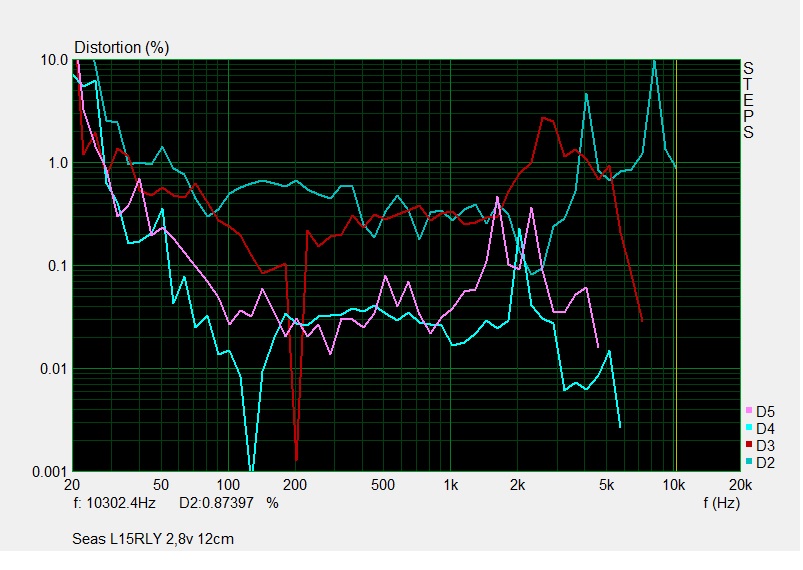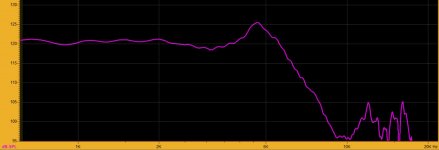Hi everyone 
I've been very interested in waveguide lately. But cant really seem to find my ground.
Since I have a small midrange and an existing 4 way design. I want to build something like it, but with a little different design and more constant directivity. So I found the Seas DXT that is so popular in Kii3 and Grimm Audio, which I also like to listen to, when I visited different exhibitions.
The DXT might be a little to small.... maybe. But I do have a 5" hard cone midrange for the project.
Then I saw on sound imports, that they have guide for waveguides - haha
SoundImports | "Wave guiding" your favorite tweeter. - SoundImports
What if I use the Seas Prestige 27TBFC/G with the Monacor WG300..... would that make a wannabe Seas DXT, but larger?
I can see on Heissmann acoustics, that the DXT can peform well. But since the price is very close - then I could not help to think that this combo might work really well.
Anyone seen someone do this?
Regards
I've been very interested in waveguide lately. But cant really seem to find my ground.
Since I have a small midrange and an existing 4 way design. I want to build something like it, but with a little different design and more constant directivity. So I found the Seas DXT that is so popular in Kii3 and Grimm Audio, which I also like to listen to, when I visited different exhibitions.
The DXT might be a little to small.... maybe. But I do have a 5" hard cone midrange for the project.
Then I saw on sound imports, that they have guide for waveguides - haha
SoundImports | "Wave guiding" your favorite tweeter. - SoundImports
What if I use the Seas Prestige 27TBFC/G with the Monacor WG300..... would that make a wannabe Seas DXT, but larger?
I can see on Heissmann acoustics, that the DXT can peform well. But since the price is very close - then I could not help to think that this combo might work really well.
Anyone seen someone do this?
Regards
Thank you. But do you mean that it's actually not needed to use a waveguide that large, to cross with a 5" . Since the DXT can be easily be crossed at 1800hz??:
DXT-MON | 5 ″ 1 ″ | Near field monitor | Compact speaker
DXT-MON | 5 ″ 1 ″ | Near field monitor | Compact speaker
I'm using WG148R to cross to Seas L15 at 1650Hz. You definitelly do not need a waveguide that large if you're using a 5" midwoofer.
I wouldn't say DXT is easilly crossed at 1800Hz. I'd say that is tje lowest crossover point with that tweeter and demands steep filter to protect it from getting damaged.
I wouldn't say DXT is easilly crossed at 1800Hz. I'd say that is tje lowest crossover point with that tweeter and demands steep filter to protect it from getting damaged.
Last edited:
Which tweeter.... cause I really like hard domesI'm using WG148R to cross to Seas L15 at 1650Hz. You definitelly do not need a waveguide that large if you're using a 5" midwoofer.
The L15 looks like it runs cleanly to 2Khz
H1141-08 L15RLY/P
So the DXT should cross fine with LR4??
H1141-08 L15RLY/P
So the DXT should cross fine with LR4??
The L15 has a very strong breakup at 8KHz. Without seeing any distortion plot, I'm a bit worried of a 1.6KHz high 5th harmonic breakup induced distortion, so maybe this is a good crossover point.
You probably don't need the WG300 with a 5" driver, and the WG148 should suffice. The latter can be mounted easily to tweeters with a flat faceplate, but the 27TBFC/G doesn't seem to fit because of the grille, you could have more luck with the soft dome equivalent TDFC.
Ralf
You probably don't need the WG300 with a 5" driver, and the WG148 should suffice. The latter can be mounted easily to tweeters with a flat faceplate, but the 27TBFC/G doesn't seem to fit because of the grille, you could have more luck with the soft dome equivalent TDFC.
Ralf
Thank you.The L15 has a very strong breakup at 8KHz. Without seeing any distortion plot, I'm a bit worried of a 1.6KHz high 5th harmonic breakup induced distortion, so maybe this is a good crossover point.
You probably don't need the WG300 with a 5" driver, and the WG148 should suffice. The latter can be mounted easily to tweeters with a flat faceplate, but the 27TBFC/G doesn't seem to fit because of the grille, you could have more luck with the soft dome equivalent TDFC.
Ralf
I have a fully active system, so with a DSP I should be able to tame the breakup - 6Khz lower than the cross-over-point??
Leaning more and more towards the DXT
Most breakup induce oddorder distortion at 1/n of the breakup frequency. So for the 8KHz breakup I expect a 3rd harmonic distortion peak at 8000/3 Hz and a 5th harmonic peak at 8000/5 = 1600 Hz.
Ralf
Quite right Ralf. 5th harmonic peaks at about 1600, so anything at or bellow that is worth looking at:

Last edited:
Quite right Ralf. 5th harmonic peaks at about 1600, so anything at or bellow that is worth looking at:

That 5th harmonic peak is actually occurring at 5 X 1600 = 8000 Hz. That's because in most distortion graphs the frequency of each harmonic is divided by its order (D2 divided by two, D3 divided by 3, etc.) so it fits in the same frequency range as the fundamental. I call this frequency scaling, but others call it frequency normalization. The attached paper explains it better than I can: see section 2 and figures 4 and 5.
REW has a feature to show this. It normally plots distortion with the harmonics' frequency scaled, but has a "Plot harmonics at the harmonic frequency" option. That option removes the frequency scaling and plots the harmonics at their actual frequencies.
Attachments
Last edited:
Get a SB Acoustics NAC/CAC hard cone. The ribs they press into the comes suppress this phenomenon considerably.
interesting
That 5th harmonic peak is actually occurring at 5 X 1600 = 8000 Hz. That's because in most distortion graphs the frequency of each harmonic is divided by its order (D2 divided by two, D3 divided by 3, etc.) so it fits in the same frequency range as the fundamental. I call this frequency scaling, but others call it frequency normalization. The attached paper explains it better than I can: see section 2 and figures 4 and 5.
REW has a feature to show this. It normally plots distortion with the harmonics' frequency scaled, but has a "Plot harmonics at the harmonic frequency" option. That option removes the frequency scaling and plots the harmonics at their actual frequencies.
Tomătoes - tomātoes
Good paper though. Thanks.
I won't be near my computer for a few days. Could you make a screenshot of that for the same measurement ?
Last edited:
View attachment 844925
My Accuton midrange starts to look pretty good, compared to many modern drivers, which seem to have more complicated breakup modes - or am I missing somethingCause the SB15CAC seem to have both a broader and almost twice as big a breakup, compared to mine

In the case of your Accuton driver the breakup starts below 5kHz, which is very low in frequency compared to newer hard cone drivers. So the breakup induced bad order (3rd, 5th..) harmonic distortions are in the middle of the main frequency range of the driver and if those harmonic distortions are not reduced somehow, they can be audible.
Maybe the SB metal drivers have broader breakup, but occurs higher in frequency (which is good because of the crossover attenuation and so) plus the induced harmonic distortions are greatly reduced thanks to the ribs and other features.
Anyway, the magnitude of the SB metal breakups are almost friendly, compared to SEAS metal cone breakups.
In the case of your Accuton driver the breakup starts below 5kHz, which is very low in frequency compared to newer hard cone drivers. So the breakup induced bad order (3rd, 5th..) harmonic distortions are in the middle of the main frequency range of the driver and if those harmonic distortions are not reduced somehow, they can be audible.
Maybe the SB metal drivers have broader breakup, but occurs higher in frequency (which is good because of the crossover attenuation and so) plus the induced harmonic distortions are greatly reduced thanks to the ribs and other features.
Anyway, the magnitude of the SB metal breakups are almost friendly, compared to SEAS metal cone breakups.
Good point
They just both look like around 10dB breakup.... so magnitude is about the same - just higher in frequency - which I can surely see as a benefit - even though I can dampen the breakup easily with my DSP. A breakup at 8Khz makes a 3-IMD at 2666hz, which is above my intented xover - which is nice.
I also read that even though you dampen a breakup - it's stille there - it still rings - just less - and maybe not audible
Hmmm... cheap, no slit cone, no exotic materials.... but looks like a very nice controlled dispersion and breakup...
Buying a Dayton Audio RS125-4 woofer? - SoundImports
Then again.... HIFIcompass thinks differently:
Dayton Audio RS125-4 | HiFiCompass
Buying a Dayton Audio RS125-4 woofer? - SoundImports
Then again.... HIFIcompass thinks differently:
Dayton Audio RS125-4 | HiFiCompass
- Status
- This old topic is closed. If you want to reopen this topic, contact a moderator using the "Report Post" button.
- Home
- Loudspeakers
- Multi-Way
- Seas DXT vs Seas 27TBFC/G + WG300
